Ipswich’s Remarkable Motorsport Heritage

In the coming months, The Race Torque will be taking a deep dive into the history of Queensland Raceway, which is celebrating its 25th birthday in 2024. To set the scene, we are first exploring the rich motorsport heritage in Ipswich, which led to the ultimate formation of the city’s motorsport precinct.
For over a century, the pioneering of the sport in the area has provided many disciplines with places to race, and some surprisingly close to the modern Willowbank hub.
Here is a selection of motoring and motorsport moments we have managed to track down in the lead-up to the modern Ipswich Motorsport Precinct – if you have information to weave into the story, we would love to hear from you. Contact us via our website or our social channels @theracetorque.
In the Beginning
From the first car appearing in Ipswich in 1903, wheels turned to see the city’s first auto club kick off in 1918.
A second club was started out of the Railway Workshops in 1925, and after a year, it grew to encompass 600 members and was subsequently affiliated with the RACQ.
As it transpires, speed was at the forefront for early motorists, with endurance and intra-city trials commonplace through Ipswich and elsewhere across the nation.
The early press regularly ran stories proclaiming the feats of motorists that would be a everyday chores in modern times.
In 1910, the Daily Telegraph in Sydney ran a story on Mr J.B. Hawthorne, who completed a Sydney to Brisbane and return via Ipswich trip in his 35hp limousine Talbot.
While Mr Hawthorne took the credit, the car was actually driven by Chauffeur Frank Braund.
The report noted that the roads between Toowoomba and Ipswich were “not fit for bullock wagons, and it took the car an hour to negotiate four miles,” while the car had to be trucked from Brisbane to Tweed Heads, such was the impassable nature of the roads at the time.
In 1914, ‘Dare-Devil’ Jenkins attempted to break the record for a car trip between Ipswich and Toowoomba.
However, on entering Ipswich, his right rear tyre departed, with the wayward rubber lucky not to take out a house window.
His time of 38 minutes from Brisbane to Ipswich, however, was noted as a record and remains seriously quick motoring to this day.
In July 1915, W. Power of Toowoomba (sounds familiar?) set a new motorcycle record between the Post Office in Toowoomba and the General Post Office in Brisbane, with the 92 miles covered in only 2hr55min.
Power fell off his Indian twice en route, and the roads were noted as being in bad condition. However, his time was 12 minutes better than the previous car record.
Earlier that year, a motorcycle reliability trial saw competitors travel from Brisbane through Ipswich to Toowoomba.
Sponsored by Dunlop, significant prizes, such as gold watches, were on the line. However, many of the starters were noted as getting lost on the journey, especially between Ipswich and Toowoomba, while one bike burned to the ground in attempting to climb the range.
Also, in 1915, Messers Alex Jewell and J. Walsh set a new Sydney-to-Brisbane record via Ipswich. Their six-cylinder Studebaker covered the course in 32hr15min, some 4hr35min quicker than the previous benchmark.
In 1917, a motor gymkhana was held at the Bundamba Racecourse, the first-ever event of its kind held in the district.
With no fewer than 10 cars entered, there was a ladies’ driving competition, a motor relay race, a motorcycle sack race, and a gent’s driving competition.
In the mid-1920s, competitive motorcycle events on the road were popular, with one meet noted as having at least 60 starters.
In 1924, the Ipswich Motorcycle Club was reported as hosting a quarter-mile acceleration test on the “Amberley Road,” which would place it in the vicinity of the modern airbase.
This event was seemingly repeated in 1938 when a flying quarter-mile event was held on the Harrisville Road near Amberley.
In 1925, handicapped flying quarter miles and acceleration tests were held on the Fernvale Road.
The same year, the RACQ held a five-day reliability touring contest from Brisbane to Bundaberg and back. The first day transited Ipswich to Dalby, and that day’s motoring featured a hill climb contest.
Around 1929, the Ipswich Motor Cycle Club continued to host acceleration tests, which were well subscribed by riders from across the region, especially since the Brisbane City Council refused to allow speed events on public roads.
Meets of this ilk were commonplace across the country during the period, while a thread of otherwise unofficial street racing has been synonymous across generations in the area.
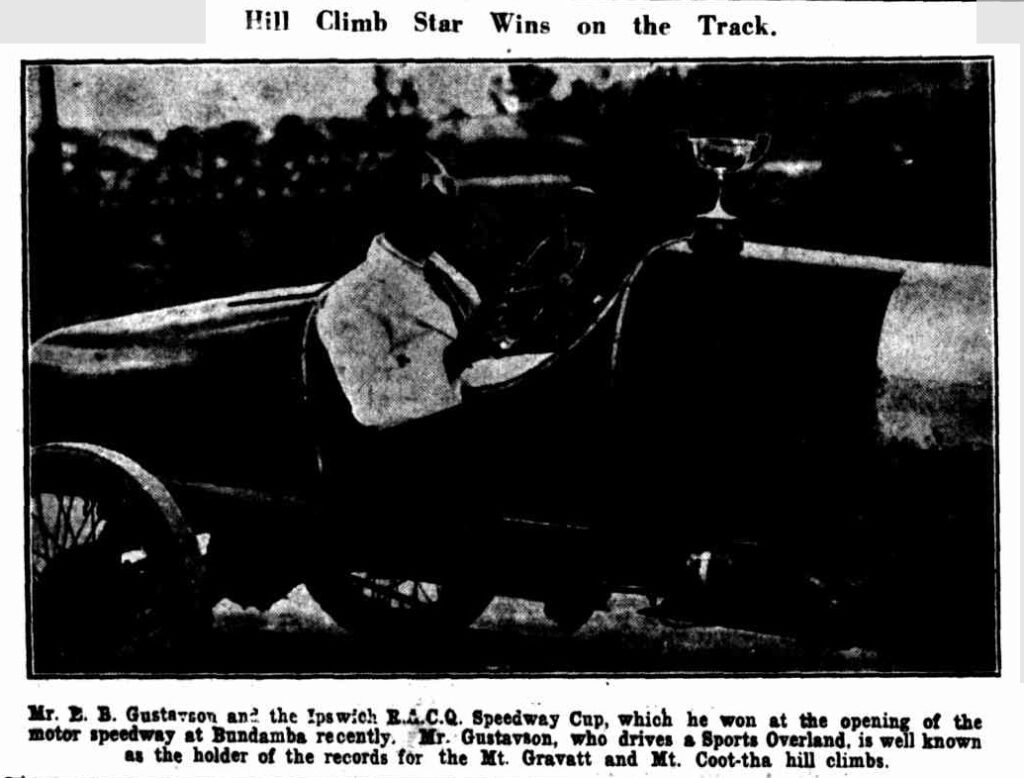
The Brisbane Courier, December 7th, 1927
Pre-war, there were multiple reports of action hosted closer to downtown Ipswich, with venues including the Ipswich Showgrounds and Bundamba Racecourse.
Cars are noted as competing in events at the 1925 Ipswich Spring Show at the Showgrounds.
However, in late 1926, the first steps were taken to use the arena as a motorcycle speedway, and the first event was ultimately contested in March 1927.
The same year, the Ipswich branch of the RACQ hosted a gymkhana at the Showgrounds, which was noted as the first truly competitive fixture for cars in Ipswich, while across town, the half-mile Bundamba Raceway Speedway also came on stream in late 1927, featuring both cars and bikes.
The Showgrounds would shut for motorsport from 1939 through 1948 and would reemerge with 2+4 meets from 1967 through 1974.

Ipswich Showgrounds – Picture Ipswich
In 1930, the Queensland Times reported on the Payne Road Race for motorcycles, as won by Bill Sloan, while hillclimbing came into fashion, a Miniature T.T. was held ‘around the trees’ at Marburg in 1934, races and acceleration tests were contested in Lowood in 1934, while events also included the “Jack Donald” hillclimb at Mount Crosby for motorcycles from 1935.
In 1936, hillclimbs were shut down in the nearby Goolman Shire after a tragic accident claimed the life of a young rider.
In 1938, flying furlongs were held out at Glenore Grove, while acceleration tests were also popular, with the Bundamba Quarry hosting scrambles and “freak hillclimbs” throughout the year.
Subsequently, the Motorcycle Club ran freak hillclimbs at Haim’s Hill, on Lobb Street, Churchill – the 1939 debut event proved to be a hit – it attracted between 500 to 600 spectators.
The events continued to be popular, although by May 1940, the Churchill meets were under fire from noise complaints from neighbours. Following a break for the war, competitions at the venue kicked off again quickly.
Freak hillclimbs were very popular at Bardon in Brisbane, with many local riders making the journey into town for the regular meets.
Pre-war speed trials were contested along Briggs Road in Raceview, which was also home to the initial track for the post-war Ipswich Junior Mini Bike Club. They then moved to Watsons Road in Ripley, briefly to Sandy Creek, Haigslea, and finally to Tivoli.
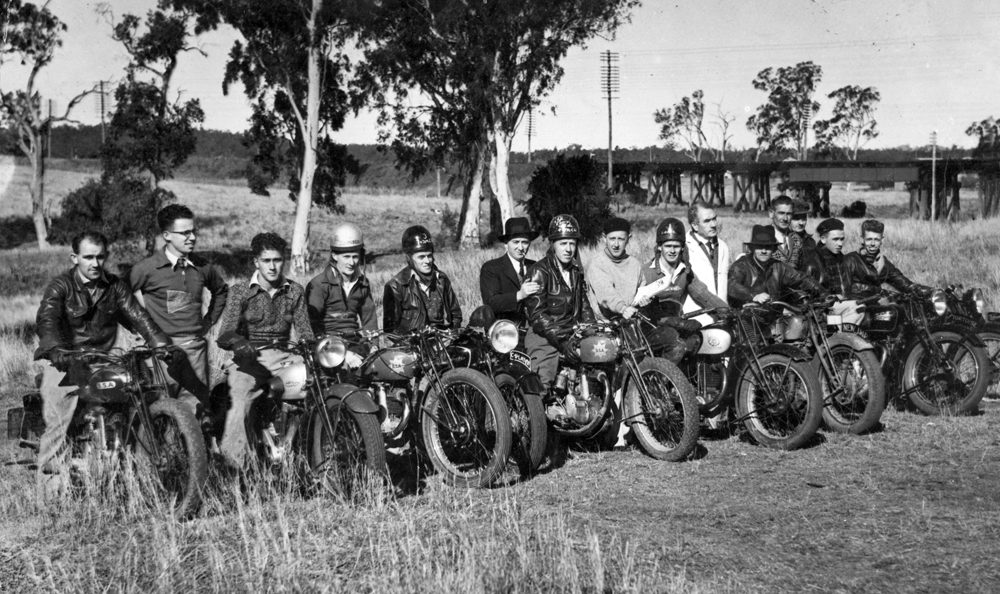
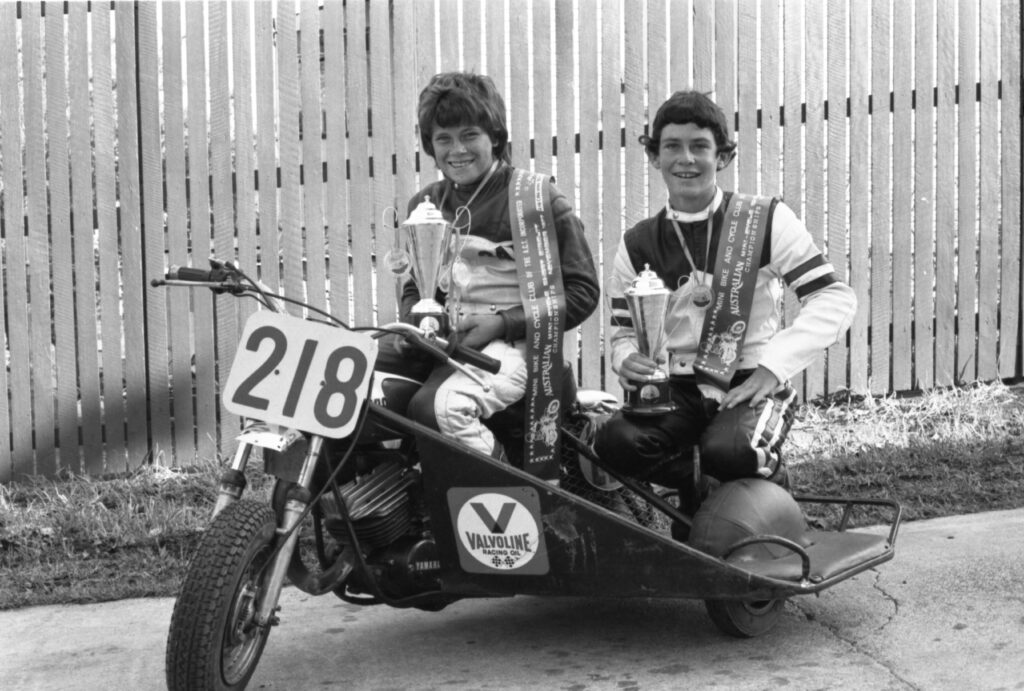
Ipswich Motorcycle Club at the Bundamba Quarry, Ipswich Junior Mini Bike Club – Picture Ipswich

Rosewood goes racing
Rewinding back to just before the onset of The War, in the closing months of 1939, a dedicated racetrack at Rosewood hosted a succession of quick-fire race meets for cars, motorcycles, and sidecars, with sideshows also including cycling and soapbox derbies.
Adding to the variety of events, stunts such as car versus motorcycle races were also contested.
Located some 9km as the crow flies northwest from the current Ipswich Motorsport Precinct, the track was constructed from the old Rosewood Racecourse.
It is believed to be one of the first dedicated motorsport tracks in Australia – up until that point, many continuing horse tracks or street circuits had been pressed into service for competition use.
The location of the circuit was about a mile walk from the train station and a right turn at the police station from Ipswich, which would suggest it was situated on the northern fringe of Rosewood and has now been swallowed up by housing.

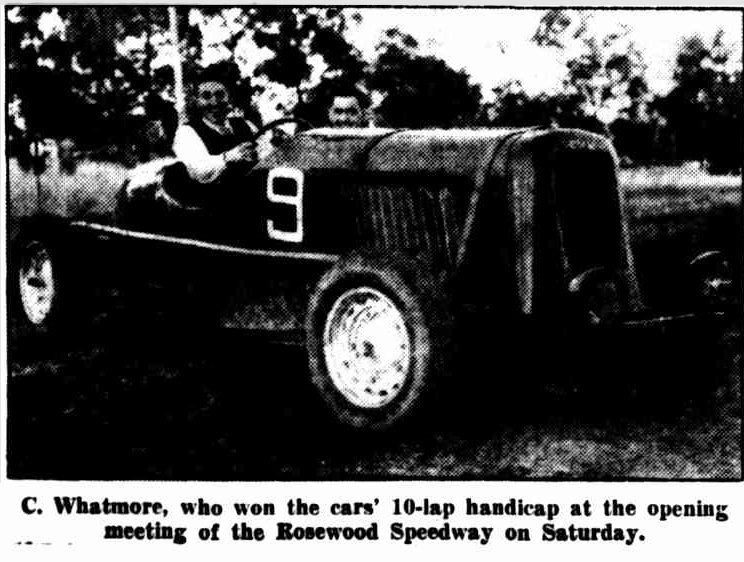
The unbanked track, about a mile long and 60 feet wide, didn’t feature any fencing; however, the block’s elevation allowed for good sight lines for spectators.
Working against the venture, the facilities were absolutely barebones, which was the number one gripe of city-slickers who journeyed west to watch horse racing at the venue.
The initial meet on August 5 drew 1,000 to 1,500 patrons along some well-beaten tracks, such was the thirst for racing at the time.
War, however, stopped any further activity, and Rosewood faded into the scrub as the nearby Amberley RAAF base sprung into life, becoming Brisbane’s main air defence station, a status which it continues to hold to this day.
The outbreak of war also meant petrol rationing, which made non-essential motoring difficult to justify.

Queensland Times, August 21st, 1946
In 1946, the Ipswich Motorcycle Club returned to hosting events, this time at the Seven Mile track, which was found on the road to Rosewood.
The three events contested at the venue included Miniature TT races, which were held on unsealed road courses, a precursor to modern-day motocross, sans jumps and obstacles.
The largest entry for a meet was 86, although heavy rains in the lead-up to October that year rendered the track inoperable.

Heit Park from over the years, Qimagery pictures
Welcome to Willowbank
If you have ever driven to Willowbank from Brisbane or Ipswich, you have almost certainly transited past a significant location from Ipswich’s motorsport past.
After rounding the bend on the Cunningham Highway, which features the turnoff to Amberley RAAF, the next landmark crossed is the Caltex Service Station on the left.
Opposite this, and bordering the modern Willowbank caravan park, is an empty, gently sloping paddock.
It was here that motorcycles raced on Heit Park, with reference to the landowners George and Jim Heit.
The track measured around 1.2km long, it featured a straight and a series of switching back corners. Running clockwise, the straight was 50ft wide, with the remainder 40ft across, with a layout that was continually tinkered with and refined over the years.

After initial hopes for the track to open in late 1946, the first event at the new raceway was contested on April 20, 1947. It was played out in front of 3,000 people, although many fans were noted as simply parking alongside the highway, watching on from over the fence.
The venue proved to be immensely popular—one meet in 1952 attracted 160 entries, while at an early event, there was consternation when one rider was sent packing after it was alleged he had earlier been banned, and was attempting to start as a ring-in.
Racing on the property concluded in 1954, just after the track commenced using starting lights for the first time, a leading innovation in Queensland.
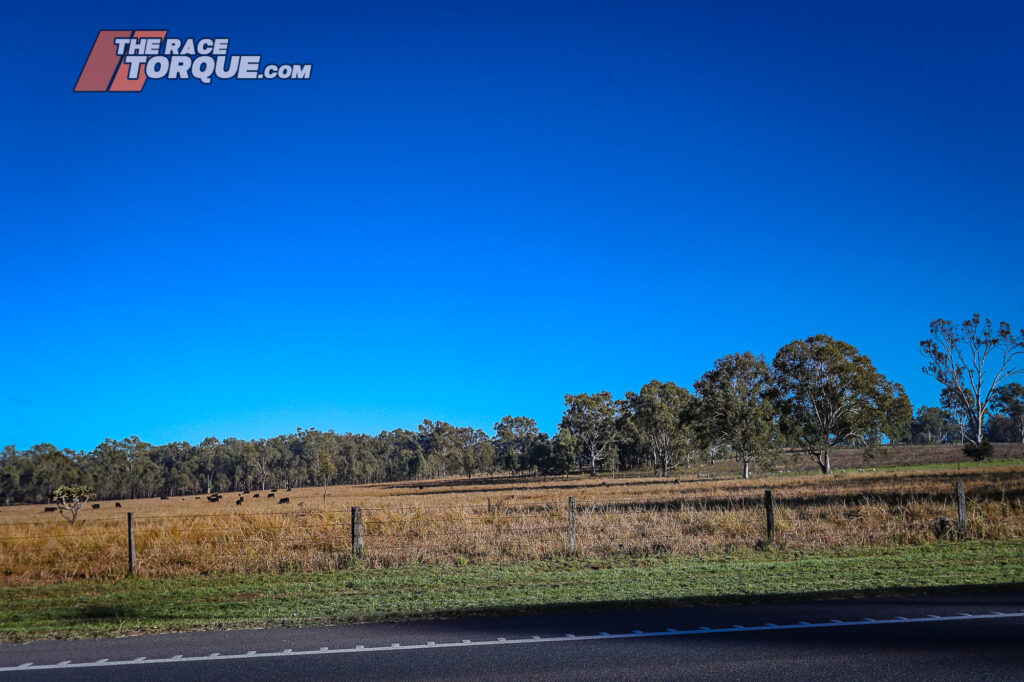
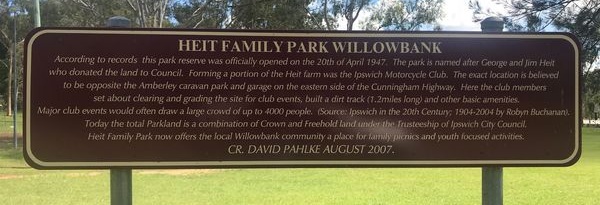
Bottom image – courtesy David Pahlke
Today, ‘Heit Family Park’, complete with its BMX track, can be found on the corner of Heit Street and Ipswich-Rosewood Road, down at the Amberley turnoff from the Cunningham Highway, with a sign denoting the area’s early motorsport heritage.
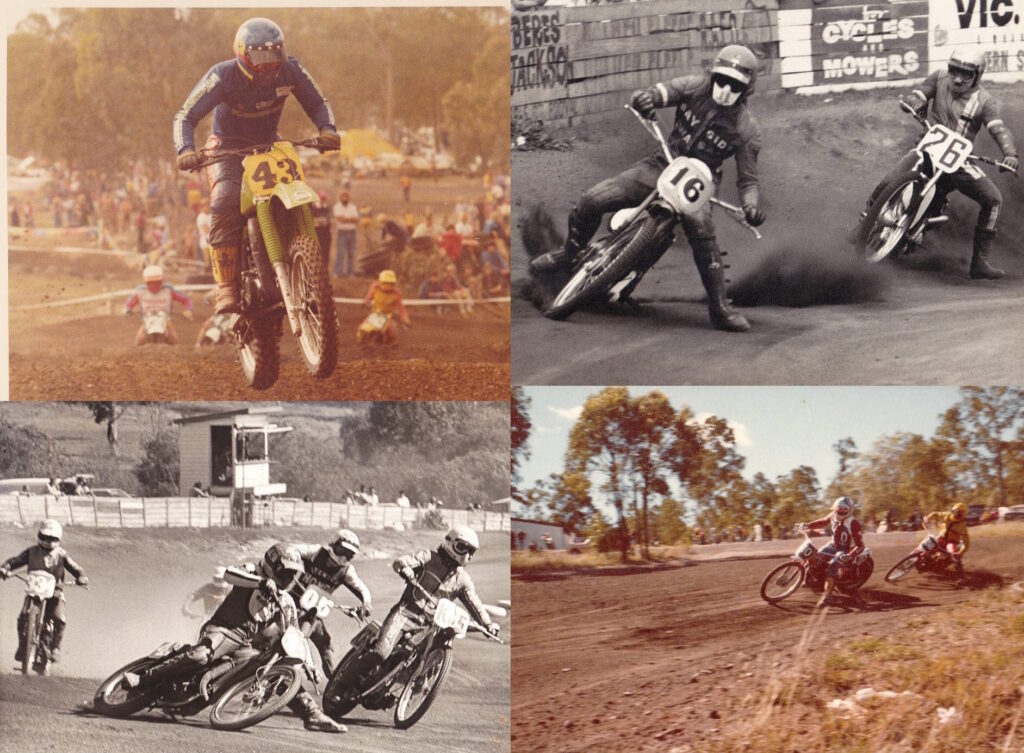

Top images: Peter Coward collection, bottom: Qimagery/Google Earth
Following on from Heit Park, motorcycle racing moved north to Tivoli Raceway on land that had been owned by motorsport interests since 1948, with racing kicking off in earnest in 1964.
The facility chopped and changed and morphed over the years with a variety of uses, from short track speedway solos and sidecars, long track racing, juniors, seniors, Stadium X and beyond.
Perhaps one of the area’s biggest motorsport exports is Leigh Diffey, who commenced his commentary career at the venue in the early 1990s.
Tivoli morphed into a modern motocross track before its ultimate shuttering, with a messy situation involving local residents, landowners Motorcycling Queensland, operators Motoland Australia, and the Ipswich City Council.
The genre of the sport subsequently reemerged in Willowbank with a privately run facility just to the north of the motorsport precinct, on the other side of the Ebenezer Coal Mine.
Motocross has long been mooted for the official precinct; however, that is a yarn for an upcoming chapter of our story…

Ipswich West Moreton Auto Club, Picture Ipswich
Elsewhere Around the Grounds
The famous Redex Trials saw locals line the streets as the convoy passed by, while rallies and off-road events regularly took place around the region.
The Ipswich West Moreton Auto Club was formed in 1954, and the Ipswich Kart Club was founded in 1958 and found a home in Mount Crosby after dabbling at sites such as the drive-in movie theatre.
The IWMAC has a particularly colourful history, running a wide range of events, from rallies and off-roading to more grassroots meets such as motorkhanas.
The club’s first-ever event was a four-hour reliability trial from Duce Car Sales to Fernvale, attracting 38 starters.
Shortly afterwards, the IWMAC obtained use of the emergency landing strip at Goolman, near Purga, while Gelignite Jack Murray was noted as an early celebrity member of the club.
Also in 1954, the club innovated by hosting a vintage car rally to Boonah, the first of its type in Queensland, with entrants dating back to a 1904 Rover.
Moving on to 1955, the club was victorious in an intra-club gymkhana held in Caboolture, the first of many successes for the group.
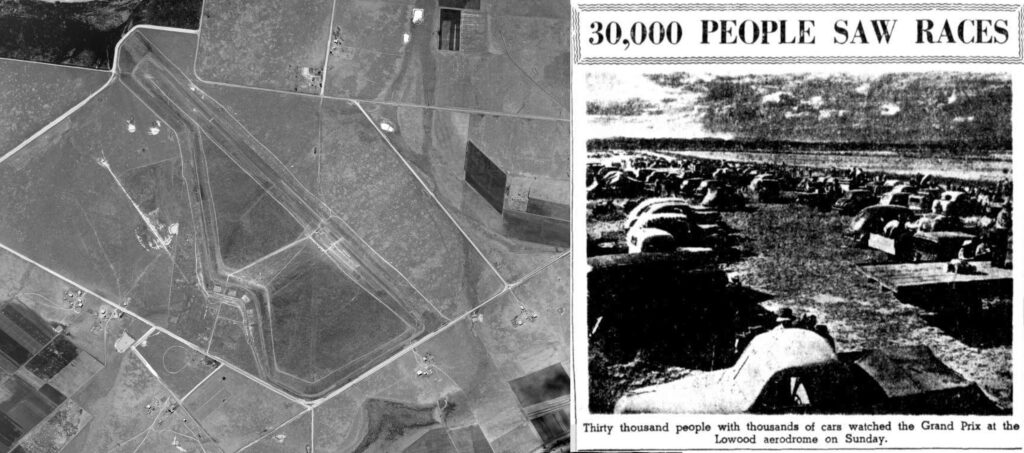
Meanwhile, the disused RAAF aerodrome at Lowood, some 25km to the north-west of downtown Ipswich, became a hub for circuit racing from 1946 to ’66, hosting most of the major events of the day, including the 1960 Australian Grand Prix, the 1961 Australian Touring Car Championship, the Australian Tourist Trophy twice, and rounds of the Australian Drivers Championship between 1957 and ’62.
Significantly, the first officially sanctioned drag racing meet in Queensland took place at Lowood on November 28, 1965, with promotion coming from the Queensland Racing Drivers Club, the MG Car Club and the IWMAC.
Run under the auspices of CAMS, the early meets largely catered to circuit racing cars and street-registered machines, with seat belts purely optional for open-top cars…
There was no Christmas tree, just a flag drop and a rudimentary timing system.
Drag racing soon gave up on Lowood and moved to the freshly built Surfers Paradise International Raceway, which was ultimately superseded by Willowbank in the 1980s.
In 1954, a “muddy” hillclimb for cars is noted as taking place at the Taylor’s Reach of the Brisbane River in Goodna.
Another casual venue on the motorsport landscape was the Amberley RAAF Base, with organised drag racing hosted on taxiway delta in the 1970s.
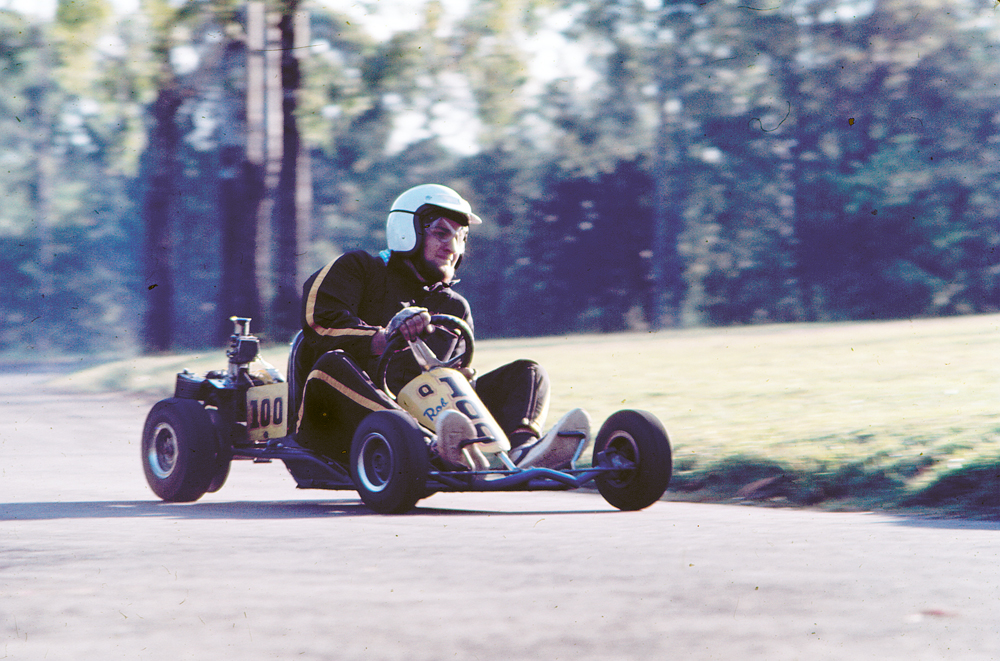

Ipswich Kart Club Mount Crosby, Queensland Times Off-Road Spectacular, Minden 1979 – Picture Ipswich







